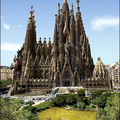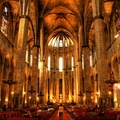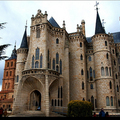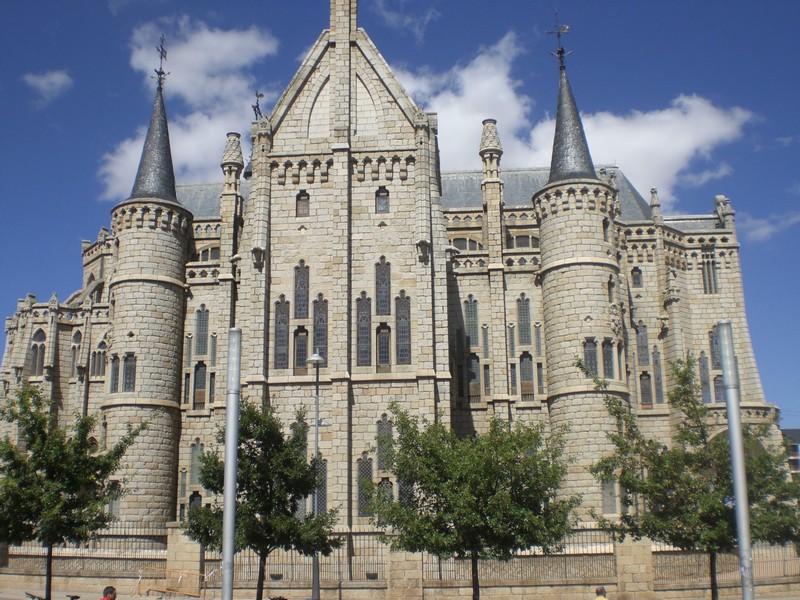Destinations / The most beautiful cathedrals of Spain / Episcopal Palace
Ads
Episcopal Palace
Sponsored Links
If in the legacy of Antoni Gaudi there exists any building in the Gothic style, that is, of course, the Episcopal Palace in Astorga, near Leon. This modest town of Astorga is widely known for this magnificent masterpiece of Gaudi.
In 1886, for dedicated service to the church, the priest Juan Grau Valespinos was assigned in Astorga, one of the first episcopacies throughout Spain, being founded in the fourth century. As a man of great energy, educational talent and pure honesty, the new prelate immediately engaged in the various transformations in the social and spiritual sphere in the province entrusted to him. Along with the opening of several schools, the foundation of the Diocesan museum, the priest engaged in the reconstruction of the episcopal palace, which was destroyed by fire. For this purpose, Bishop Grau, a native of the village of Reus in Tarragona, addressed to his famous countryman, Antonio Gaudi. For Gaudi, this request came not exactly at the right time since he was already working on the project of Sagrada Familia and was in the process of building the Palace Güell, but to refuse the new project he could not.
Agreeing to take on the project, the master clearly complicated his situation. Not being able to go to Astorga for a topographic analysis of terrain, the architect asked for a large number of drawings and photographs of the land and surrounding places for future construction plans, on the basis of which he has developed a detailed draft of the palace. The bishop was delighted by his plans, sketches and drawings although the Royal Academy of Fine Arts of San Fernando adopted a less enthusiastic attitude (its consent was required). Until the bishop Grau was alive, the master worked quietly in accordance with his own plan. After his death, the Academy insisted twice on reviewing the plans for the palace, although Gaudi presented for both times the detail plans of the project, to prevent at least partially the expected harsh reactions. After multiple rewrites and revisions, the project finally was approved. And in 1989 the construction of the palace began.
The exterior of the Palace was developed by Gaudi in a neo-Gothic style promoted by Viollet-le-Duc. According to the theory of the latter one, the search for the new architecture must begin with an examination of old Gothic buildings, although a direct imitation of them was not recommended. Gaudi skillfully followed this program, reproducing historical patterns sometimes overly punctual. The entire building was planned in the form of a Greek cross with round towers. The unusual entrance with three arches, figure downward sloping, supports an open circular gallery in the Gothic Revival style. Smooth transition from a broad base of the palace for several tapered top allows natural light to penetrate even into the hall and ground floor rooms, not to mention the Gothic hall of the dining room on the second floor with lots of windows, completely flooded with light. The capitals of its columns in the main floor of the palace reveal the influence of French Gothic style, and the eight-pointed star-shaped abacus accurately reproduces the originals from the Saint-Chapelle in Paris. However, the rest of the gothic style building looks less well-appointed and certain in Gothic style. The Round Tower, for example, is most attributable to fortifications than to a church. Only the unusually bright interior because of the many windows of the refectory hall on the second floor really gives the impression of Gothic style.
To complete the main facade of the Palace, Gaudi used white granite, which was an innovation in his practice. The new material was extremely impressive, as the master was keen to ensure that the palace would visually remind of the dazzling white robes of bishops. It was assumed that the roof of the palace would have the same color, which was prevented by the circumstances. Bishop Grau died before the completion of the construction and management of the diocese has long ago showed negative attitude towards the plans of Gaudi. They immediately tried to intervene in them, and forced the architect to come to a retaliatory ultimatum. And in 1893, the freedom-loving Gaudi could not stand the constant control and bickering from the Academy and the inertia and ill-natured attitude of people in the province and refused to continue the work, and in fury burned the building project, vowing to never come back to Astorga, not even fly over this city in a balloon. As a result, the palace was left uncompleted.
Only in 1909, after the change of several architects, Ricardo Gereta completed the construction of the palace, in accordance with the intended project of Gaudí. Nowadays, the Episcopal Palace is certainly among the best Spanish Gothic monuments.
Sponsored Links
By Maria Morari
Sponsored Links
Maps of Episcopal Palace
map SpainOthers from The most beautiful cathedrals of Spain
Check out Spain's most sacred destinations!
Images of Episcopal Palace, icons, photos, figures, visions, appearances, illustrations, snapshots, captures, canvas and pictures of Episcopal Palace - The most beautiful cathedrals of Spain
Sponsored Links
Sponsored Links






















